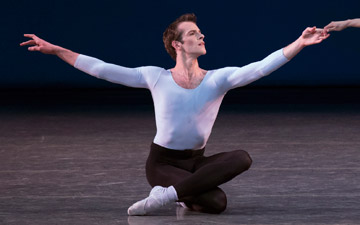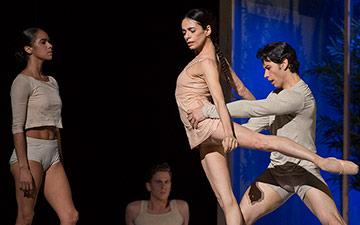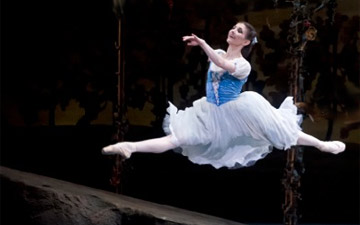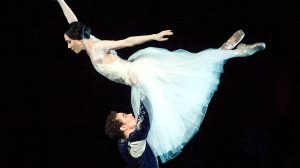
© Rosalie O’Connor. (Click image for larger version)
American Ballet Theatre
Giselle
★★★★✰
New York, David H. Koch Theater
21, 22, and 23 October 2021
www.abt.org
davidhkochtheater.com
Giselle Unbound
The story of this week at American Ballet Theatre has been the story of a ballet company finding its footing after more than a year away from the stage. Over the course of several days, ABT has reintroduced itself to its audience, introducing a slew of new principal dancers in the process. With each passing day, the company looked stronger and made an increasingly coherent and convincing case for Giselle. What looked pallid and almost quaint on opening night had recovered its liveliness and emotional power by the weekend.
I caught four débuts in the lead roles of Giselle and Albrecht: Skylar Brandt with Herman Cornejo on Oct. 21, Thomas Forster alongside Gillian Murphy on Oct. 22, and both Cassandra Trenary and Calvin Royal III at the Oct. 22 matinee. There were also débuts in the roles of Hilarion (Jarod Curley and Patrick Frenette) and Myrta (Katherine Williams and Stephanie Petersen), the peasant pas de deux, and other secondary roles. I saw you, Courtney Lavine, playing the haughtiest Bathilde ever, and Duncan Lyle, furiously fretting over the Count’s poor life choices. (There was one additional cast of débutants, Christine Shevchenko and Aran Bell, which I didn’t get to see.)

© João Menegussi. (Click image for larger version)
All this to say, American Ballet Theatre is alive and well and brimming with talent. Each Giselle brought a slightly different interpretation; all were technically strong, even if there were, as one might expect, a few bobbles here and there. I was happy to see that Giselle-as-fragile-victim is not the only option on the table at ABT. Both Murphy and Trenary were feisty, as the original Giselle was, if one is to believe recent reconstructions of the ballet. There were hair-raising mad scenes (Trenary), and quietly devastating ones (Murphy). Among the male dancers, the interpretation of Albrecht as cad predominated, a choice that makes good sense but, to my eye, robs the character of humanity and makes him difficult to like, at least in the first act. A loving, sensitive Albrecht is easier to forgive.
Interestingly, only one of the four Albrechts I saw, Thomas Forster, opted to do the series of entrechats six in the second act that used to be standard at ABT in this role. The others executed a diagonal of brisés toward Myrta. But the brisés, which were also Baryshnikov’s preference, are only exciting if they are fast and headlong, as if pushed forward by a wind. These were perfectly nice brisés, but added little to the drama of the moment. After all, this is Albrecht’s last gasp. Forster’s entrechats, both high and cleanly executed, had the desired effect: they made you hold your breath, and your pulse race.
Forster, a longtime soloist with the company, recently promoted to principal, was making his New York début at the age of 35. (He danced the ballet just once before the pandemic, in Washington.) I found him the most touching of all the Albrechts I saw. He is a natural actor, able to communicate feelings and thoughts without doing much. His walk through the forest to Giselle’s grave had both simplicity and pathos. When he stopped and peered into the darkness, you could almost read his thoughts. At the end of the ballet, he cried on Giselle’s grave before standing up and wandering off into the forest, a poetic, hopeful choice. His first overhead lift was slightly wobbly, and his stamina was tested in the second act, but he compensated with a nice high passé, big jumps, and beautiful turns.
He danced with Gillian Murphy, with whom he had a warm, playful rapport. He treated her gently, she responded with delight and enthusiasm. The two seemed to be playing a game together. Murphy, a powerhouse, danced with easy, full-bodied virtuosity. Her mad scene was pared down, and very focused. After wavering in the perilous unsupported second act arabesque penchée, her dancing recovered its usual glow. In her last embrace of Albrecht, there was real, human affection.

© João Menegussi. (Click image for larger version)
On Oct. 22, Herman Cornejo danced with the polish he brings to every role. Every landing was in a perfect fifth position, every cabriole a double, every step clean and clear. He was paired with Brandt, also a technically assured dancer. Her hops on pointe in the first act traveled all the way across the stage, and her turns in attitude at the start of the second were a blur of tulle. Both these and other moments were met with well-deserved applause. Brandt’s was a performance of sheer technical and interpretative command, in which every detail had been thought out and perfected. Her Giselle is very much in the febrile, wide-eyed vein, somehow doomed from the start; it will be interesting to see her explore more, and different colors over time. But she is every inch a ballerina.
The stakes at the Oct. 23 matinée were even higher, in that both of the leads were having their débuts. I believe Calvin Royal III may be the first Black Albrecht I’ve seen in years of ballet-going, notable in and of itself. He and Cassandra Trenary have danced together before, most recently in Alexei Ratmansky’s The Seasons and in a filmed version of the balcony scene in Kenneth Macmillan’s Romeo and Juliet. Just before the pandemic, he was about to perform a series of important débuts, of which Giselle was one.
Royal is elegant and lithe and extremely beautiful, while Trenary is petite and fiery and dramatic. In Giselle, this contrast reverses the usual dynamic of dashing interloper and shy village girl. Trenary’s Giselle is irrepressible, unafraid to take up with a stranger and to test her mother’s patience. Albrecht doesn’t have to do much cajoling; this Giselle loves to dance and can’t wait to introduce her new beau to all her friends. At one point, she caresses his arm, as if amazed at his beauty. How can he not fall in love with her?

© Rosalie O’Connor. (Click image for larger version)
Their dancing, too, revealed intriguing contrasts. Royal was assured and un-forced, opting for beautifully executed single cabrioles, for example, which looked especially good because of his long limbs. She, on the other hand, stretched and pushed her dancing; hers was a hungry performance, and an exciting one. A mishap in the diagonal of hops on pointe did not deter her from a circle of piqué turns at breakneck speed immediately afterwards. Her mad scene was epic, complete with trembling hands, accusatory gestures, and slaps to the head. This was a no-holds-barred Giselle.
These performances were backed up the corps de ballet of Wilis, moving and breathing together as one, obeying their Queen. Their dancing was a particular highlight, as were performances in the role of Moyna and Zulma (lead Wilis) by Sierra Armstrong and Isadora Loyola. In the corps, Chloe Misseldine and Zimmi Coker stood out for the focus and fullness of their dancing. Andrii Ishchuk, Jarod Curley, and Patrick Frenette were all excellent in the role of Hilarion, Giselle’s jilted village suitor. Poor fellow, he really gets the short end of the stick.
I saw a company whose confidence grew with each performance, gradually cajoling this shop-warn production back to life. Maybe, after everything that has happened, it’s harder to believe in Giselle’s radically simplified worldview. But step by step, the magic returned.

















You must be logged in to post a comment.